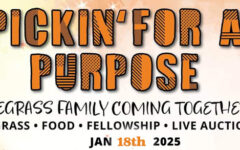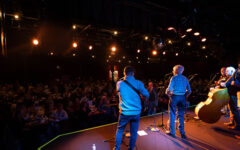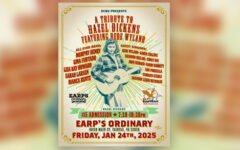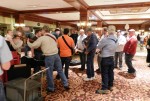 This past weekend at the Music City Sheraton in Nashville, TN, the Society for the Preservation of Blue Grass Music in America (SPBGMA, pronounced “spigma”), held its 38th Annual Convention & Awards. This convention is a multi-faceted event comprised of performances, vendor exhibits, a band contest, SPBGMA’s annual awards, what is doubtless the primary draw for many — some of the best jamming opportunities to be found anywhere, anytime.
This past weekend at the Music City Sheraton in Nashville, TN, the Society for the Preservation of Blue Grass Music in America (SPBGMA, pronounced “spigma”), held its 38th Annual Convention & Awards. This convention is a multi-faceted event comprised of performances, vendor exhibits, a band contest, SPBGMA’s annual awards, what is doubtless the primary draw for many — some of the best jamming opportunities to be found anywhere, anytime.
As it has been going on for 38 years, I remember hearing about the event in my early days of playing in the late 70’s, but never attended until the early 1990’s. When we arrived for the first time, we drove up to a stately southern plantation manor-style structure on a hill outside of downtown Nashville. Greeted by a nicely uniformed bellman, we entered a large lobby appointed with marble, brass, carved hardwood, a 20-foot ceiling, et cetera — a beautiful Sheraton hotel, and we were immediately struck by the sight of something we had never seen before or since.
THE JAMMING
Everywhere throughout the hotel, elbow-to-elbow in the lobby, bluegrass music fills the air. Unlike most of the indoor events I have seen, there was jamming in every nook and cranny (I know what a nook is, but I’ve really got to research what a cranny is) — the lobby, the hallways, the stairwells, guestrooms, the exhibit halls, even once an elevator opened with passengers picking. The hotel staff embraces the event (not concerned with impressing their usual business traveler clientele, they dress casually for the weekend — but no straw hats or coveralls).
Unlike IBMA, where activities are more varied, more spread out in different locations throughout the convention center, the hotel, and the entire town, and where the hotel is occupied at the same time with other group meetings and business travelers, the Sheraton is entirely occupied by SPBGMA. There are no off-limit areas to jamming (except immediately outside the concert hall), and is permitted 24 hours on the first floor.
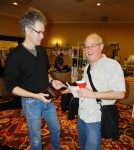 Because of its location (the number of bands that work out of Nashville), and the time of year (which is traditionally a pretty dead time for working bluegrass bands), the event attracts a large percentage of the professional mainstream bluegrass bands to attend and participate, either by performing a showcase (translated: a free or reduced-fee performance), or just hanging out and jamming. There aren’t many places you could go and stand next to Carl Jackson, Adam Steffey, Pete Wernick, Ron Block, Scott Vestal, David Parmley, Barry Bales, Dan Tymnski, et cetera, jamming in combinations you won’t likely ever see on stage, let alone having the opportunity to join in. Before his death, Jimmy Martin, the King of Bluegrass, held court in the Sheraton lobby every year.
Because of its location (the number of bands that work out of Nashville), and the time of year (which is traditionally a pretty dead time for working bluegrass bands), the event attracts a large percentage of the professional mainstream bluegrass bands to attend and participate, either by performing a showcase (translated: a free or reduced-fee performance), or just hanging out and jamming. There aren’t many places you could go and stand next to Carl Jackson, Adam Steffey, Pete Wernick, Ron Block, Scott Vestal, David Parmley, Barry Bales, Dan Tymnski, et cetera, jamming in combinations you won’t likely ever see on stage, let alone having the opportunity to join in. Before his death, Jimmy Martin, the King of Bluegrass, held court in the Sheraton lobby every year.
The various strategies employed are interesting to watch. There are bands (both professional and semi-professional seeking a higher profile) who jam in the “main arena” of the lobby, or the main first floor passages between the lobby and the concert hall, seeking to be seen and noticed. There are bands who don’t want to fight the wall of sound, but still want to be seen and heard, so they tend to resort to the stairwells, upper floor hallways, or the “we’re trying not to seem attention-seeking so we jam in our room, but we prop the door open to draw visitors in.” Then there’s the effective “wait until all the wee hours when most have gone to bed” before we come out and take the main-lobby stage. The best jam session I ever participated in, featuring mostly pros (I remember Jason Carter and Kevin Church) didn’t start until around 2:00 a.m. in the main lobby.
THE INTERNATIONAL BAND CONTEST
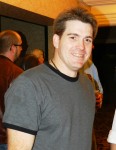 Our first visit in the early 90’s to SPBGMA’s Nashville convention (they also have a Midwest convention) was to perform a showcase, which had been arranged as part of the prize (traveling to Nashville at our expense to perform for free, is that a prize?) for winning a regional contest. After our first visit, and having a large time, we came back several times to enter the International Band Championship competition.
Our first visit in the early 90’s to SPBGMA’s Nashville convention (they also have a Midwest convention) was to perform a showcase, which had been arranged as part of the prize (traveling to Nashville at our expense to perform for free, is that a prize?) for winning a regional contest. After our first visit, and having a large time, we came back several times to enter the International Band Championship competition.
Starting Saturday morning, the contest usually attracted approximately 40 bands in the 90’s, reduced to 25 after the first round, and fifteen after the second round, culminating in the awarding of cash prizes to the top ten after the final round on Sunday. Although we finished in the top 10 every time we entered, we were never able to win, which I say without embarrassment, both because of the subjectivity involved in such events, as well as the talent that a $4,000 first prize attracts.
When we came back a couple years ago, we decided to forego the competition. Although it was always nice to have the prize money to defray the trip expenses, we always tended to be focused entirely on getting ready for the next round of the contest and didn’t get to enjoy as much of the jamming and networking opportunities that make the event so much fun.
EXHIBITS
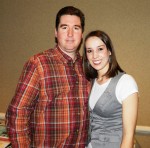 The exhibits are certainly not comparable to the exhibits at IBMA, with the large spacious booths, large aisles and open layout. However, crowded into two smaller rooms with narrow aisles there is an elbow-to-elbow excitement that certainly adds a nice piece to the overall interest SPBGMA generates for fans and musicians alike.
The exhibits are certainly not comparable to the exhibits at IBMA, with the large spacious booths, large aisles and open layout. However, crowded into two smaller rooms with narrow aisles there is an elbow-to-elbow excitement that certainly adds a nice piece to the overall interest SPBGMA generates for fans and musicians alike.
Another effective technique employed by many exhibitors (which saves them booth rental) is to rent a room, usually a suite, and set up headquarters for the weekend. This year, I noticed that Huber Banjos, Arthur Hatfield (banjo luthier and setup master), and the Sally Gap (KY) Bluegrass Festival all employed this method, usually accompanied by signs and/or flyers to direct attendees to their rooms.
Following this lead, Valerie and I hosted a party/showcase/jam in our suite last year and again this year, printing flyers and posting them throughout the hotel and handing out our business cards with our room number on them. Aside from being effective in gaining attention, making contacts, and actually getting bookings (the primary objective), we had a lot of fun. Don Rigsby dropped in and played about an hour with us, blending his great voice in a powerful duet with Valerie.
AWARDS
 Of the at least 7 or 8 times we’ve attended the event, we’ve never stayed for the awards, which are voted upon by convention attendees thoughout the weekend, and handed out at an evening production (typical mixture of awards and performances) on Sunday. While I’m sure it’s a wonderful experience for the nominees and recipients, we’ve always needed to be on the road home by Sunday evening.
Of the at least 7 or 8 times we’ve attended the event, we’ve never stayed for the awards, which are voted upon by convention attendees thoughout the weekend, and handed out at an evening production (typical mixture of awards and performances) on Sunday. While I’m sure it’s a wonderful experience for the nominees and recipients, we’ve always needed to be on the road home by Sunday evening.
Now is as good a time as any to address the “elephant in the room” when it comes to SPBGMA. When you note that the organization is dedicated to the “preservation” of bluegrass in “America,” combined with the contest rules which do not allow any electric instrument, including electric bass, you probably get an immediate feel for the organization’s outlook toward the music, which is decidedly to the traditional side. This is not international, not “big tent,” and not encouraging experimentation.
This outlook probably influences the awards, and there have been some head scratchers the first few times I paid any attention to who was nominated for, and won, awards, including persons I had never heard of (after 15 years of being totally immersed in bluegrass and playing professionally myself), and nominees for “Guitar Performer of The Year” who only play rhythm, not lead.
This is not to say that all of the groups that perform or compete are playing only first generation styles (Monroe, Stanley, Flatt & Scruggs, etc.). I use the term mainstream to encompass not only those more traditional styles, but also the New South, Quicksilver, LRB, IIIrd Tyme Out, etc., as well as what we do with a female vocalist, electric bass, and open use of material from various musical genres, even if modified to “bluegrassify” it. You will hear all of this at SPBGMA, but you won’t hear tambourines, jam bands, heavily rock or folk influenced styles. Whether that is good or bad is up to you to decide.
WRAPUP
What SPBGMA is about for us, and why we will go back as often as we can, is fun. After the previous festival season seems a distant memory and even IBMA has been months ago, SPBGMA is a great chance to reconvene with the professional bluegrass community and to hear and play the music we love. We got to visit and talk at length with Sam Passamano, II (head of Rural Rhythm Records), Mike Scott, Barry Waldrep, Larry Stephenson, and many more of the movers and shakers in bluegrass.
I’ll be filing new stories about things we discussed.

